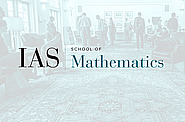2007-2008 seminars
Oct
16
2007
Computer Science/Discrete Mathematics Seminar II
Sparse Random Linear Codes are Locally Decodable and Testable
10:30am|S-101
Oct
15
2007
Computer Science/Discrete Mathematics Seminar I
Extractors and Rank Extractors for Polynomial Sources
11:15am|S-101
Oct
09
2007
Computer Science/Discrete Mathematics Seminar II
<a href = "http://www.math.ias.edu/~agarber/RImpagliazzo/abstract.pdf">New Proofs of (New) Direct Product Theorems</a>
10:30am|S-101
Oct
08
2007
Oct
02
2007
Computer Science/Discrete Mathematics Seminar II
Unbounded-Error Communication Complexity of Symmetric Functions
Alexander Sherstov
10:30am|S-101
